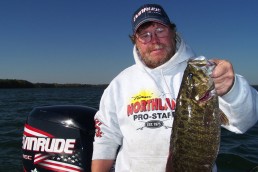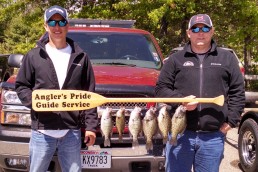Perfecting the Deadstick for Walleyes
SHARE THIS POST
It’s called the “one-two punch” when ice fishing—jigging one line and deadsticking, or, basically a live minnow under a bobber for the other. The idea is the jigging line attracts walleyes, and if they are active, there’s a good chance they’ll whack at whatever is being jigged. When some walleyes turn to more of a neutral mood, the deadstick can be hot. Success with one isn’t just about hanging a live minnow under a bobber. By really paying attention and knowing some nuances, the deadstick can be lively.
Traditional deadstick
The most common setup is a plain hook or ice jig with a minnow hooked just under the dorsal fin under a bobber set 1 foot off of the bottom. This setup catches a lot of walleyes, but when fish don’t react very well to this presentation, mix it up.
Raise it up
After dozens of hours watching fish react to my presentations on my Vexilar, there have been numerous times I’d set my rod down to grab something. Then, often, my lure would be hanging 3 feet off of the bottom. Many times I’d watch a red line rise slowly off of the bottom to eat my suspended offering. Walleyes are used to feeding up or even sliding up in the water column to catch minnows. Sometimes it can be very effective, and almost triggers them when you have a live minnow on your deadstick set higher up in a water column vs. 6 inches to a foot off, which is a normal starting spot for many anglers.
Color
Color makes a difference and can change from hour to hour based on snow cover, cloud cover and the angle of the sun. When you are fishing with someone, try different colors until you figure out what the walleyes want. Details, such as the color of your hook, will make a difference. This came into play recently while fishing with a buddy as he was using a glow hook with a dead shiner. For whatever reason, that was the ticket that day. That deadstick caught the majority of the walleyes and saugers that day. Something about the glow hook combined with dead bait was the ticket. Paying attention to color will pay dividends. In stained water, gold, glow and bright colors are good. In clear water, silvers and natural colors are good to start with.
Deadstick lures
There are a lot of effective ice jigs for deadsticking on the market. A plain jig head with a minnow will work, but there are other options. The Jig-O-Bit uses a Kahle hook attached to a lead head in a variety of colors. With a live minnow, it hangs nicely. The Demon is a well-known crappie bait, but the larger-sized baits do well for walleyes and saugers. The Danlure Jig is a unique jig that has a swivel between the lead head and the hook, allowing the minnow more freedom to swim at different angles.
Some deadstick baits have propellers or small spinners, UV glow paint, glitter, rattles, a single hook, treble hooks, etc. Again, experiment until you find the preference for that day or for that particular body of water.
Good electronics really help the process of deciding when or if to change lures. If fish are coming through and not reacting positively to your offering, it is time to change things up. Without electronics, it would be harder to know if the fish are not reacting or if they are there or not.
Change the flavor
Walleyes can be particular: one day they prefer fatheads, the next day it has to be emerald shiners, on others a good rainbow will do the trick. The trick here is have at least a couple of different options of minnows and have both options down in the same fish house if you are with a partner or two. The walleyes will tell you what they prefer that day and eventually everyone can hone in.
Are you enjoying this post?
You can be among the first to get the latest info on where to go, what to use and how to use it!
On a recent fishing trip on Lake of the Woods, a buddy tried hooking a dead emerald and caught a nice walleye. He again reached for a dead minnow after the live minnow, and caught another. For whatever reason, the dead minnow that day combined with a glow hook was the ticket and caught twice as many as the live minnows. It is good to experiment.
Size does matter
Size can relate to the ice jig you use. At times, walleyes will prefer something larger, as it is a bigger target, acts differently and makes more noise. A larger jig can also have a different action, and the minnow cannot roam as freely. In other cases, when you jig it you can bang it on the bottom, which can cause the fish to become active.
Size also matters when considering bait. Some days the fish prefer a larger minnow and other days, especially when in a neutral mood, they prefer a very small minnow. There have been many times when a crappie minnow is my most desired minnow among a bucket of larger minnows. The point is, experiment and figure out what the fish want.
Hook that minnow
The most common way to hook a minnow is just under the dorsal fin. Another nuance is to clip off half of the tail of the minnow, which in turn changes the vibration of the swimming minnow. The minnow will also work harder to swim, often enticing a finicky walleye.
Some anglers will hook the minnow through the mouth, giving it a different look. Others will hook the minnow back by the tail, but on the bottom or underbelly of the minnow. This causes the minnow to sit upside-down in which they will work hard to upright themselves, triggering a bite.
Remove the bobber
Many years ago on LOW, we were fishing the afternoon bite before it got dark. One of the anglers with me was a longtime guide. Instead of using a bobber on his deadstick line, he had a fairly flexible tip on the end of his rod and would lay the rod over a bucket with the minnow set at the desired depth. Instead of watching the bobber, which can be difficult to detect the light bites, the walleyes would then lower his rod tip with just their slightest bite. The angler then picked the rod up slowly, feel just a bit of weight, and nail them. The thought process is when fish are just breathing on the minnow the bobber isn’t as sensitive as a flexible rod tip. He out-fished the other two of us in the house that day with his deadstick alone. It made me wonder how many times a walleye hit my bobber line and I didn’t notice. After that instance, I will lay my deadstick line over a 5-gallon pail or on a bench next to me where I can see the tip move when a walleye or sauger breathes on it.
Deadsticks often don’t receive the attention the jigging line does; it’s one of those lines that are often set and left alone. However, there are many days when a deadstick can be the most productive rod in the fish house. Paying attention to details and trying a variety of presentations will increase the number of walleyes and saugers pulled through the ice. It may not be as sexy as the jigging line, but on any given day, the deadstick can definitely be as productive.
MWO
SHARE THIS POST
Did you enjoy this post?
You can be among the first to get the latest info on where to go, what to use and how to use it!
Joe Henry
Tournament angler and licensed charter captain Joe Henry fishes and hunts the Midwest. Henry is a media member of AGLOW and writes for numerous publications, creates videos, appears on a variety of outdoor TV and radio shows and is a frequent seminar speaker. Henry is the Executive Director of Lake of the Woods Tourism.



